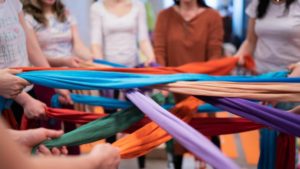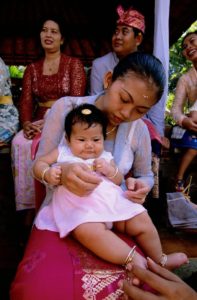250 babies are born every minute across the globe? By the time you finish reading this post, close to 1,250 babies will have come earthside! Birth is a singular experience. Each with a birth story all it’s own. Yet it’s also a universal experience. At any given moment, 250 birthing people are laboring together, working hard to bring their babies into the world.
My name is Celene Carrara and I am a birth doula. I’ve been curious about birth and cultural birth traditions since my younger sister’s homebirth in Bali, Indonesia. As a 3 year old child, I witnessed the raw, powerful, and transformative energy of her birth and it left a profound impression on me. Today as a doula, I’m honored to support families as they welcome their own babies and write their own birth stories.
While I am trained to provide emotional and physical support, a key element of my service is education. Knowledge is power; it’s what facilitates an informed, cohesive, and empowered birth experience. And since no birth is the same, a well-rounded understanding of how your birth may manifest is beneficial. Between evidence-based research, formal childbirth ed. classes, and even your family birth history, there is plenty to absorb.
Today, I’m thrilled to share a handful of birth customs from around the world. It is my intention that in learning about these traditions, you may see just how wide and diverse the birth spectrum is. The prenatal period, labor, and life postpartum do not abide by any one formula – there is no right or wrong way. I hope that these stories broaden your perspective and connect you to the thousands of families celebrating life postpartum with their little one.
If you have a question, comment, or birth tradition you’d love to share, let’s connect! I currently offer birth doula services and bengkung belly binding. To learn more, visit www.awenbirth.com. Please be in touch at awenbirth@gmail.com and stay up to date on my doula adventures @awenbirth.
MEXICO

A rebozo is a traditional Mexican shawl, about four or five feet long, that is used during labor and is facilitated by a birth partner. This technique has been passed down through generations and can be used in many ways. For example, a rebozo helps to relax the pelvic muscles and to support the weight of the birthing person during labor. Traditional midwives will even utilize the rebozo to flip babies in utero.
JAPAN
Stemming from an ancient Buddhist belief that labor pains must be endured as a test to prepare for motherhood, most Japanese women aim to deliver without painkillers, including epidurals. After the baby is born, the new mom traditionally rests in bed for 21 days at her parents’ home while family members take care of chores. During this time, friends and family stop by to greet the new baby and join in eating osekihan, a celebratory red rice and red bean dish.
In Japan, loud, crying babies are believed to be healthier and will grow faster. Crying contests, known as nakizumo, are held and the loudest baby is crowned victor!
JAMAICA
After a baby is born, the placenta and umbilical cord are saved and planted in a sacred location by the parents. Family or friends bring a tree to mark the spot. As the child grows up, he or she will be charged with taking care of the tree—an innovative lesson in responsibility.
BALI, INDONESIA
 Birth in Bali is seen as a rebirth or reincarnation, as the majority of the population is Hindu. Newborns are considered holy and are thus protected by a team of spirits. As a baby’s soul transitions to the Earthly plane, its feet are forbidden to touch the ground for the first 105 days of life.
Birth in Bali is seen as a rebirth or reincarnation, as the majority of the population is Hindu. Newborns are considered holy and are thus protected by a team of spirits. As a baby’s soul transitions to the Earthly plane, its feet are forbidden to touch the ground for the first 105 days of life.
On the 105th day, the family gathers to celebrate Nyabutan, a ceremony to thank the spirits for protecting the baby. Offerings are made, the infant is blessed by a priest, and then the baby touches the earth for the first time.
LATIN AMERICA
To help ease into motherhood, moms observe la cuarentena. This 40-day tradition is based on the belief that a new mother’s body is vulnerable, “open,” and needs to be protected as it heals. After birth, a big support system of women take care of mother and newborn. The team changes diapers, cleans the house, cooks special meals, prepares herbal baths, holds the baby while mom naps, and makes sure mom is comfy cozy.
Mothers are encouraged to relax in bed the first week postpartum and begin to leave the house for brief periods after 30 days. At 40 days, they are ready to be out in world.
MALAYSIA
Malaysian postpartum traditions are based on practices that promote rest and healing. Mothers observe a 45-day period known as pantang, or confinement. Often it is the mother-in-law that takes charge of the pantang with the help of other female relatives and friends. Malaysian mothers enjoy massage, herbal baths and medicinal tonics, and bengkung belly wraps as they transition from pregnancy to motherhood.
VIETNAM
In Vietnam, babies are potty trained from birth and are expected to be diaper-free by the time they are 9 months old! The tradition is called “Pavlovian Potty-training.” Parents and grandparents learn baby’s unique bathroom cues and make a whistling sound when the cues are observed. By 3 months, parents prop their babies on the potty, whistle, and watch their little ones go on command!
THE NETHERLANDS
 Most mothers in Holland are cared for by a local midwifery practice and personally decide whether they want a home or hospital delivery. Doctors only intervene in high-risk cases or if complications arise during labor. In fact, all expectant moms are required to pick up a kraampakket, a kit that includes the medical supplies necessary for a home birth. The Dutch system of kraamhulp, or maternity home care, begins after baby is born. Insurance covers the assistance of a nurse at home for 7 days postpartum. Similar to a postpartum doula, this nurse prepares meals, tidies the home, and offers guidance to new parents.
Most mothers in Holland are cared for by a local midwifery practice and personally decide whether they want a home or hospital delivery. Doctors only intervene in high-risk cases or if complications arise during labor. In fact, all expectant moms are required to pick up a kraampakket, a kit that includes the medical supplies necessary for a home birth. The Dutch system of kraamhulp, or maternity home care, begins after baby is born. Insurance covers the assistance of a nurse at home for 7 days postpartum. Similar to a postpartum doula, this nurse prepares meals, tidies the home, and offers guidance to new parents.
About Celene:
 I witnessed my first birth at home in Bali, Indonesia. Even as a child of three years old, the raw and powerful energy was transformative. Out of that energy, my sister was born, and I was gifted a life-long companion.
I witnessed my first birth at home in Bali, Indonesia. Even as a child of three years old, the raw and powerful energy was transformative. Out of that energy, my sister was born, and I was gifted a life-long companion.
My life’s joy is to empower birthing people so that they may bring their children into the world with gentleness and compassion.
My innate gifts combined with my formal education and passion for birth guided me to become a doula. I wear many hats in this role: educator, assistant, and friend. It is my deep belief that in respecting birth, we honor birthing people, their babies, and life itself. It’s sacred. It’s magic. It’s awen.

